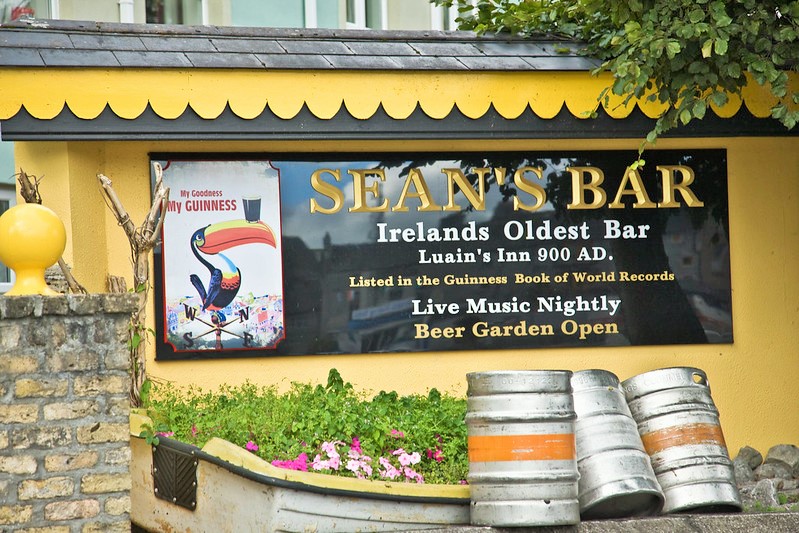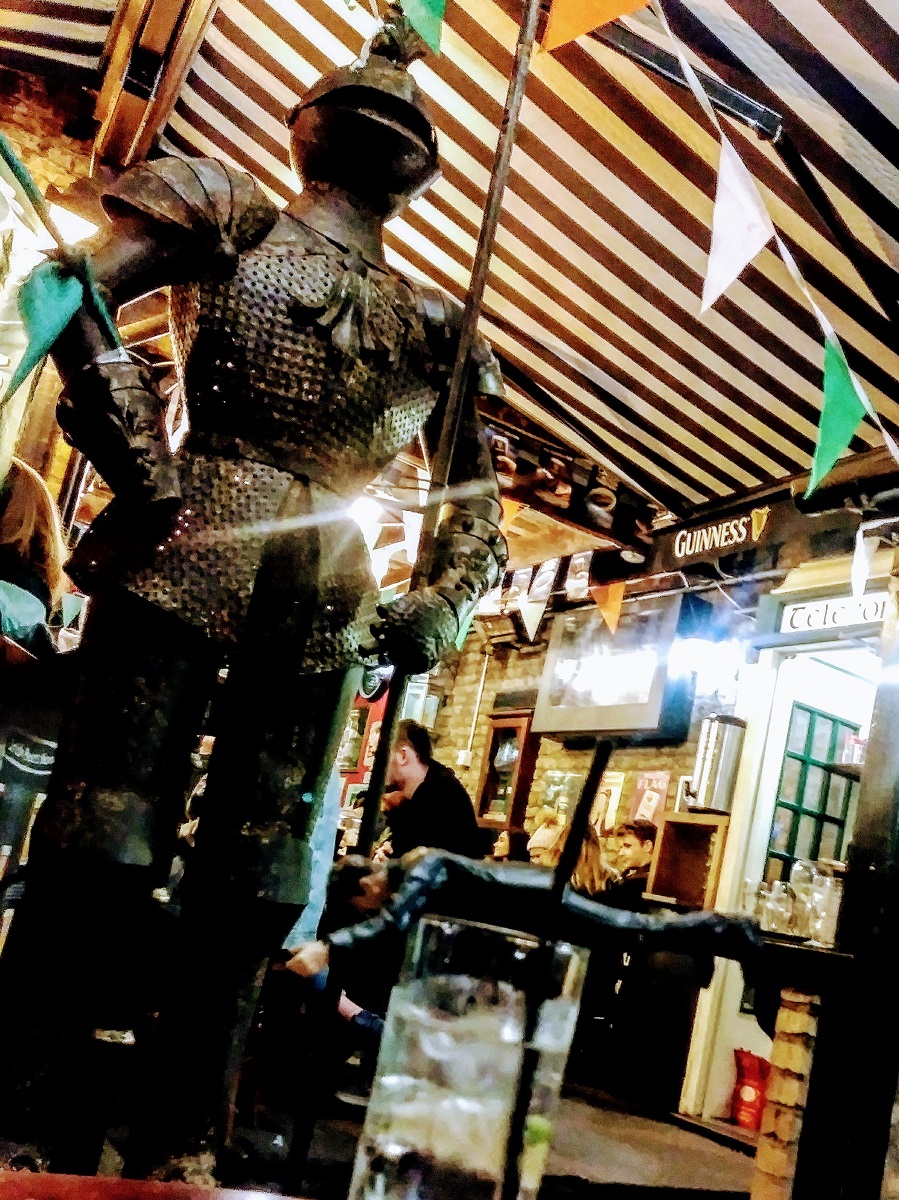After a grueling travel-day, rather traversing open highways, riding miles of luxury rails or flying the crowded skies, what is the first thing most of us want to do upon our destination-arrival? Nap, right? No? Not nap. Okay. Next best thing? Drink, right? Yes! Drink and stroll, or as the Germans say, Wanderwegen. Explore your new digs, meander, ramble at a leisurely pace; you're not dashing to your terminal now, or sprinting down a train platform. Chill, weary traveller, you've got loads of time. Get your geographic bearings and, a.s.a.p., find a cheery, lively place to rest and sample local libations and noshes. Better yet, find a place chockablock with local colour, just bleeding history from its walls.
Notably, if you've traveled a long distance, say, overseas, jet lag is your enemy and from the moment you touch down, he's just waiting down a cobblestone alley, to whack you in the brain with a bag of Euros and leave you there to wallow in a daze for a good ten to twelve hours. Fret not, dear pilgrim, for bright lights, fresh air and hearty convo are lethal to jet lag. Bring on the nom nom noms, adult beverages and local colour. Take that, Jet Lag!

As early as 1198, land records cite "a hostlery" was established on the River Liffey, in what was then known as Ball-ya-Awha-Clia: "The Town of the Ford of the Reed Hurdles". Before civil engineering made medieval Irish life less of a soul-crushing, seemingly pointless slog, the best way to cross the Liffey was at low tide, on foot. Ancient logicians knew the value of an efficient, river crossing and set up a safe, if not soggy, striding path. When the tide allowed, reed mats were lain across the river bed and for a few hours, travellers and their loads made their way to whatever business - for there was likely little pleasure-travel in the Ireland of the Dark Ages - called across the Liffey. What little pleasures did exist, happily, could be found right off the mats, at an establishment on the banks of the LIffey and flush with hooch, snackies and good cheer, awaiting weary travellers.
Within a decade of the original hostlery construction, fresh for a new century, the Normans saw a smarter way to cross the Liffey and replaced the reed mats with a bridge, in 1210. By 1214, the relatively new bridge, clearly in a poor state all too quickly, needed replacing and England's King John allowed for Dublin to engineer a new bridge "should they so wish". That wooden bridge held up a bit better, until 1385, when it finally collapsed. In that year, the third bridge on that spot was built, this time by the Irish-Catholic Dominican Order and, adhering to progressively greater engineering standards, lasted well into the 18thC. Today's Liffey crossing is the Father Matthew Bridge - originally named for Lord Lieutenant, Charles, Earl of Whitworth - and was built in 1818. Until 1674, on this spot over the Liffey, at the Bridge Street quay, where The Brazen Head sits today, was the river's only bridge-crossing.
As early as 1693, The Brazen Head is first documented, and again in 1700, appearing in a legal writ, owing to an debt dating back to 1613 and the original landowners, Richard and Elinor Fagan. Yet, it is not until 1754 that The BH is distinctly erected as an inn, a coaching inn, specifically. Two years later, in 1756, after renovations, the first advert appears:
Christopher Quinn of The Brazen Head in Bridge Street has fitted said house with neat accommodations and commodious cellars for said business.
Most great metropoli are water-situated. Go ahead, ask History ... I'll wait. Paris, New York, Hong Kong, Cairo, Boston, Philadelphia, Copenhagen, Amsterdam, Vienna, San Francisco, Bakersfield ... oh, wait ... all world-class societies were erected on major waterways. We are made of mostly water; we, as humanoids, come from the water, evolution-wise. Water is vital for life. It also ain't bad for commerce and tourism, remarkably ancient commerce and religious-tourism, as it serves our story. Well before Norwegian Air, Easy Jet and Aer Lingus could get you anywhere on the planet in a snap, for relatively little coinage, waterways were the easy-peasiest way to travel. When a young city draws travellers, it cultivates citizens; when a growing town cultivates citizens, it breeds politics. When a viable town breeds politics, it manifests passion and passion, oft times, sparks revolution.
Similar to Boston, Philadelphia, Paris and Williamsburg - towns where revolution quietly began in local pubs, taverns and coffeehouses - so did Dublin draw its share of passionate pols and, therein, revolutionaries. According to The Brazen Head's historian, "Its proximity to the quay, the churches and the law courts also made it a hub for gossip and an ideal place for strangers to pass on their intelligence in secret."
At the end of the 18thC., meeting discreetly at The Brazen Head, United Irishmen and Robert Emmet concocted the Rising of 1798, a proposed overthrow of British-ruled Dublin Castle, just around the corner from The BH: quick right, quick left. Emmet rented a room therein and, like any sage yet, rightly, paranoid revolutionary, secured a room with a window overlooking the front door, assuring he could see assassins before they could see him. In the end, it all went very badly for Emmet and room-choice mattered not a whit. (If your inner Velma Dinkley is looking a twee ghost adventure, Emmet is said to haunt the upper floors of The Brazen Head,, still keeping eye for the law.)
In 1916, the United Irishmen returned, this time with Michael Collins and a host of other leaders during the War of Independence. It is miraculous The Brazen Head escaped total destruction, as both Anti-Treaty/British troops and Free State/Irish troops were stationed, at various times, on both the corner just outside The Brazen Head and in front of The Four Courts, just across the Liffey. During the Easter Rising of 1916, the rebel (Free State/Irish) garrison, stationed outside The Four Courts and led by Cmdt. Ned Daly, fired across the Lffey at British troops stationed outside The Brazen Head. Conversely, during the Civil War of 1922, British troops, then stationed at The Four Courts fired across the Liffey at Free State Troops, then stationed outside The Brazen Head. Bonkers! Tell me all those chaps didn't need a pint. During these years of strife, fire was a constant threat, as flames engulfed The Four Courts during the Civil War, and The BH was regularly an easy mark for any accidental or intentional fires, bomb detonations and any manner of militaristic crossfire.
Amidst calmer tides, The Brazen Head's history has been replete with writers, because, if you're not writing in front of other people, it doesn't count, right? From Trinity-grad Jonathan Swift (Gulliver's Travels, Battle of the Books) and James Joyce (Ulysses, Finnegans Wake) to playwright Bredan Behan (The Quare Fellow, An Giall) and even Yours Truly (Savannah of Williamsburg, The Darlings of Orange County), writers of all stripes and stages of success have called TBH a warm and friendly, temporary office.
As The Brazen Head's suit of arms can attest, even Tiny Mulder needed a rest, and a G&T, after a long-haul flight from L.A.. Natch, The Brazen Head was his first stop. (Tiny Mulder also needed a nap, as you can see.) Be it a brief stop for a weary traveller, a long night of great craic amongst strangers and besties, or a noisy afternoon where a writer can observe, fold-in and note the world, The Brazen Head proffers warm and welcoming arms, a smile down every hallway and a hearty back-slap on every stool. Come on in and stay a while, weary travellers, friends and strangers, one and all.
Sláinte!
*Aside, there are two musings on two bits of BH history:
1) Is The Brazen Head Ireland's oldest pub?
2) Why is The Brazen Head named as such?
Allow JennyPop to elucidate, fair reader ...
Is it the oldest? (Now, presented for you are clear facts. Let it be known JennyPop loves The Brazen Head and, in all transparency, has yet to visit Seáns Bar, Ireland's other Oldest Bar.) So, official documentation, for the land and buildings as a unit, dates to 1613: ownership by an Irish family of high-standing, on the wife's side, Richard and Elinor Fagan. It should also be noted, there is, in court records, documentation for a "substantial building" on this spot circa 1500.
However ... Seán's Bar, in Athlone, Ireland, halfway between Dublin and Galway, on the River Shannon, "south of Lough Ree and north of the ancient monastic monastery at Clonmacnoise", where the Shannon intersects with the Esker Riada, not only dates as Ireland's Oldest Pub, having been established and continuously running since 900CE, but was authenticated in 2004, by Guinness World Records, as Europe's Oldest Pub. Located at 13 Main Street in Athlone, make the trek and stay a bit for a couple o' fingers of Seán's Bar Specially Blended Irish Whiskey - Luain Edition: named Luain after the very first innkeeper of this bar.
Of cultural-anthropological interest, similar to The Brazen Head and the River Liffey, Luain escorted travellers across the River Shannon, on reed mats at low tide. Eventually, a settlement erected around these river banks, when King Turlough O’Connor commissioned Ireland's first wooden castle, in 1129. Today, Athlone (in Irish, Atha Luain) is named after Luain, that first innkeeper and river guide. As of 2020, Seáns Bar has stood for 1,120 years. Sláinte agatsa, Seán and Luain!!


Now, back to The Brazen Head and its namesake. Most agree it was named for the mystical brass, or brazen, head of Norse, Celtic and Arabian folklore. Like a Magic 8-Ball, a brazen head was purported to proffer cryptic advice, when asked. There is some chatter though, that TBH was named for brazier, or brazen, barrels: fire baskets which used to stand outside the building, keeping travellers and troops alike warm during the earliest days of The BH.
What thinkst thou? LMK @JennyPop! Happy St. Patrick's Day, all!!



